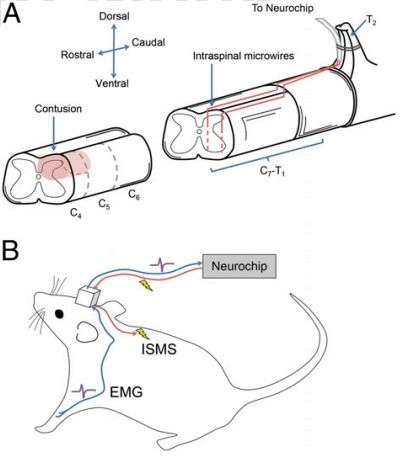September 15, 2015 report
New electrostatic stimulation technique improves damaged-nerve function in rats

(Medical Xpress)—A team of researchers at the University of Washington in the U.S. has developed a new technique to help restore function in an animal with a damaged spine. In their paper published in Proceedings of the National Academy of Sciences, the team describes their new technique and why they believe it will eventually lead to helping human patients.
When important nerves are damaged in humans and other animals, it typically means loss of use of body parts—spinal injuries, for example can prevent people from moving their arms and legs. Treatment for people with such injuries depends on the severity of the injury—for those with only partial damage, physical therapy is suggested, and in some cases electrostatic stimulation. In this new effort, the team has come up with a technique that extends what is already being used and is based on work done to help patients with epilepsy and/or chronic pain.
In the new technique, the researchers surgically implanted a neurochip in a rat brain which allowed for noting and recording the electrical signals generated when the rat performed a certain physical action, such as reaching though a slot for a bit of food. Afterwards, the rat was given a partial spine injury which prevented it from reaching for the food as it had done in the past. To help it recover, the researchers sent an electrical signal to the damaged area at the same time as the rat was attempting to move its foot (as noted by the neurochip) the way it had before the damage occurred. That addition of synchronized stimulation over the course of three months, the team reports resulted in an increase in function that was approximately two times that for physical therapy alone or random electrostatic stimulation. They report that over the course of three months, the rats treated with the new technique recovered on average 63 percent of their former abilities, compared to 30 percent for rats treated using conventional means. They also report that the improved neural function remained weeks after the treatment.
The team suggests that their technique could help human patients as well, but more testing will have to be done before that can happen—they are confident that once approved, the technique will help restore movement, bladder, bowel and sexual function and reduce pain.
More information: Targeted, activity-dependent spinal stimulation produces long-lasting motor recovery in chronic cervical spinal cord injury, Jacob G. McPherson, DOI: 10.1073/pnas.1505383112
Abstract
Use-dependent movement therapies can lead to partial recovery of motor function after neurological injury. We attempted to improve recovery by developing a neuroprosthetic intervention that enhances movement therapy by directing spike timing-dependent plasticity in spared motor pathways. Using a recurrent neural–computer interface in rats with a cervical contusion of the spinal cord, we synchronized intraspinal microstimulation below the injury with the arrival of functionally related volitional motor commands signaled by muscle activity in the impaired forelimb. Stimulation was delivered during physical retraining of a forelimb behavior and throughout the day for 3 mo. Rats receiving this targeted, activity-dependent spinal stimulation (TADSS) exhibited markedly enhanced recovery compared with animals receiving targeted but open-loop spinal stimulation and rats receiving physical retraining alone. On a forelimb reach and grasp task, TADSS animals recovered 63% of their preinjury ability, more than two times the performance level achieved by the other therapy groups. Therapeutic gains were maintained for 3 additional wk without stimulation. The results suggest that activity-dependent spinal stimulation can induce neural plasticity that improves behavioral recovery after spinal cord injury.
© 2015 Medical Xpress















